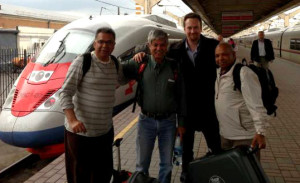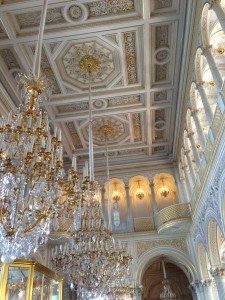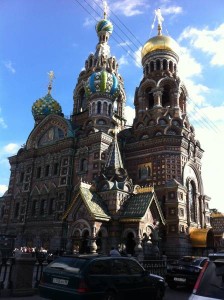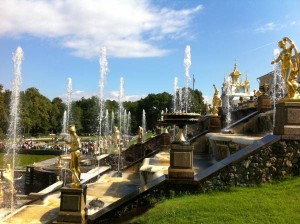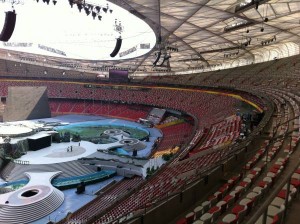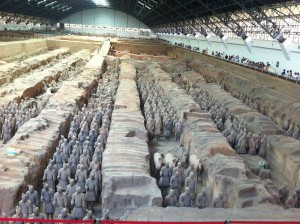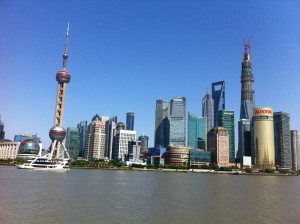From Russia with love
One of the colourful Church with blue spires in Moscow that are there all over in the city
By Vijay Badhwar
Trans-Siberian travel has its unique ”˜wow’ appeal. With embellishments like the world’s longest train journey along the borders of the Gulag country, the Trans-Siberian travel becomes once in a lifetime experience.
When the intrepid traveller K K Gupta, formerly Air India’s Manager in Sydney, initiated the idea a year ago with two fellow lovers of adventure – Ashok Malik and myself – it immediately bonded into a team eager to experience the never never land replete with stories of intrigue and hardship, a land of extremes which, once upon a time, only had an entry but no exit.
Regular meetings to plan the journey became an excuse to down umpteen glasses of beer at the Bowlers’ Club in Sydney, a journey more pleasant than the rigours of applying for visas and going through the train schedules. In the end there was nothing organised (did not like to be tied down with itineraries), laisser faire, except doing the bare minimum ”“ to obtain the visas, air tickets and the first accommodation when we landed in Moscow. What could happen to three old men, we thought.
Russia is certainly not looking for tourists; the country is still in a paradox whether to open itself up to the world or remain in the shadows. The visa rules are cumbersome requiring an invitation from a Russian hotel which they provide at a fee and can be arranged directly or through a travel agent. The invitation can be emailed or faxed and attached with the application, a mere formality. Later, on arrival, tourists are required to register themselves with the police which the hotel arranges at a fee.
We prepared for much more as we had booked our Delhi-Moscow flight with Aeroflot. But to our surprise the aircraft was a shimmering airbus, the service even better than most top-rung airlines.
The stark Moscow airport lacked energy but the six-lane roads beyond slowly opened up a mega city. The mid-rise buildings on either side of the road were unostentatious and of a similar character. It is said that Stalin, after his visit to US, was so impressed with the Empire State Building that he got seven of them built all around the city.
Colourful domes and spires of orthodox churches add spice to the city architecture, each one a masterpiece in its own right. More than 10,000 of these churches were razed to the ground in the Stalin era to eradicate religion from the society, we were told during the free bus tour of the city.
Big cars lined the kerb side along all roads – latest model BMWs, Mercedes and Audis with silhouettes of drivers visible through darkened windows. We longed for the sight of a real Oligarch getting into the car but were disappointed.
There was a time when we heard of long queues outside shops but the shelves were empty. But now there were huge shopping centres with exclusive shops which sell label brands galore but there are no buyers. There were only shop assistants who wandered around the shops aimlessly.
The Kremlin area, Red Square and the famous landmark ”“ St Basil’s Cathedral (Church of the Saviour) were the main attractions in Moscow besides many world class museums and art galleries. The area, indeed grand, swarmed with tourists. A cruise in Moskva River was another way to see the architectural highlights of the city.
Public travel in Russia is very cheap. While the taxi fares are most times negotiated and may cost anywhere between $40-70, a metro or a bus ride to far flung places within the city are only about a dollar. The Metro stations are also a must see, built deep underground and accessed by massive escalators. Each one is a sculpted piece of art in granite and marble with chandeliers that will befit a palace. These are indeed a sight to behold.
Language remains the biggest barrier for English-speaking tourists. As all the signs and names are in Cyrillic script (thankfully the number of letters provides the clue) and virtually no one speaks English, it becomes hard to move around.
We had gone unprepared not having booked our Trans-Siberian journey and virtually reached a desperation point at the ticket windows unable to explain either orally or in writing. This was until a guardian angel arrived asking if he could be of any assistance. We were flabbergasted.
Tourists, from Left: Ashok Malik, Vijay Badhwar and KK Gupta with our guardian angel Moscovite, Lev
Lev, a young lawyer, met us every evening after work and sorted out all our travel arrangements. We came across many other instances when the otherwise stern looking Russians went out of their way to help.
The train from Moscow to St Petersburg is the most modern mode of transport in Russia has developed with German collaboration. It covers a distance of 650 km in less than four hours at speeds touching 200 km/H.
St Petersburg rivals successfully with Brussels and Paris as the world’s most beautiful city as for as architecture starting from Renaissance period is concerned.
Hermitage museum – one of the best in the world
The prodigious public square outside the Hermitage Museum where the human dimension becomes inconsequential relative to the space around is absolutely awe-inspiring.
Church of Resurrection in St Petersburgh known for its mosaics
The Hermitage Museum itself is among the world’s best where just walking through would be a sin. It would need several days, if not weeks, if justice is to be done to appreciate its art collection. One is at a loss where to pay attention to: should it be the ceiling or the floor, the walls or the artefacts.
The Hermitage Museum had a humble beginning when a Russian banker gifted some paintings to Catherine the Great. These were stored in an annexe of the Winter Palace. But in the following years it became a tradition to donate artwork to win state favours as with the Nizam of Hydrabad in India. There are now more than three million catalogued works which can not be displayed at one time even in the entire three wings of the palace.
For a casual visitor to St Petersburg, a visit to St Isaac’s Cathedral and the Church of the Saviour on Blood are famous tourist haunts. The former is a colossal work of art of stained glass windows and carved doors, walls laden with mosaics and gold-trimmed paintings. The interior of the Church of the Saviour is exclusively of mosaics that is a sight to behold.
Some of the 147 fountains at Peterhof on the outskirts of St Petersburgh – a sight to behold
On the outskirts of St Petersburg is Peterhof, a palace built by Peter the Great that is famous for its gravity-fed fountains. The city is full of other attractions, among them its world-renowned metro stations. We spent an entire day just admiring the underground stations, getting on and off from the metros, for a mere three Roubles (15 cents), the public transport being so cheap in Russia.
Back in Moscow, we started the Trans-Siberian train journey eastwards towards Vladivostok, a distance of 9289 kms, longest train journey in the world, announced proudly on a pillar at the station. We had planned not to go all the way to Vladivostok but changing over at Irktusk, Lake Baikal, to Trans-Mongolian towards Mongolia and then China. In hindsight, it turned out to be the right thing to do to escape the long monologue with an unchanging landscape.
The railway built in the early 20th century was a major engineering challenge not only due to the inaccessible terrain but also due to permafrost in large sections under the tracks. It was constructed by nothing more than wooden shovels by Italian, Turkish and Chinese labour earlier and then by convict labour whose sentence was reduced by four months for eight month’s work.
The Trans-Siberian train is alike an Indian express train that also travels at a comparable speed but powered by electricity. Its four-berth, two tier kupe’ is also similar to its Indian counterpart, smaller and with compartments replacing the curtains that separate the aisles from the berths. Two attendants (provodnitsa) work alternatively in 12-hour shifts to clean the carriage, lock/unlock the toilets when the train is 10 minutes on either side of a town, lower/raise steps when the train stops at a station and provide hot water in the samovars.
Although August is the peak season of travel, our carriage was mostly empty virtually all through the journey. Whoever boarded the carriage ended up in our compartment sharing many cans of beer and conversing with mere looks and appreciative laughter.
The dining car many carriages apart was also empty and provided the option of the same soup, same grilled chicken for breakfast, lunch and dinner. Passing the carriages on the way to the dining car we realised that local Russians carried their own bread, cheese and cold meats which they supplemented whenever the train stopped at the stations.
Irkutsk, the fur capital of Russia and a town at the edge of Lake Baikal was four nights away from Moscow. As there were no shower facilities in the train, we managed to refresh ourselves with a wet towel soaked in boiling water from the samovar. The time virtually stood still as did the landscape of the Ural forests. We just imagined that it would be only a month when everything would be under of blanket of thick snow for the next nine months.
Irkutsk is a busy trading town. Shared Mercedes vans ply frequently to and fro to Lake Baikal, some 60 kms away, to run a continuous stream of tourists. The lake is like a vast sea of fresh water, which, it is said, can supply drinking water to the whole humankind for 40 years if there was no other source of water left on earth.
The Trans-Mongolian from Irkutsk travels towards the southern tip of the lake and then along its western bank for more than eight hours as it heads towards the Russian border.
It is an irksome process to cross a border in the train. The guards take the passports away; so the passengers can not leave the carriage. The toilets are locked as the train is at a station. It is put on hold for the next four or so hours.
AS part of the cross-border checks, the dogs entered to sniff around. And the police started going through the luggage and then all the nooks and corners. They got the Mongolian attendants to remove the runner in the aisle and then unscrew a lid in the corridor where the linen was stored. They asked the attendant to get inside the pit and remove everything. This was right outside our compartment.
We watched with bated breath as the rather heavy attendant was sweating inside the pit. Out came from underneath the pillows and blankets boxes after boxes of something. It took more than an hour as the corridor filled with stacks of those removed items. There was a problem and we were witness to that, we thought.
But, to our surprise, after all this sweating and drama, the boxes ended up in the attendant’s cabin and everyone was drinking and we heard bouts of laughter. Matters had been sorted out to mutual benefit, we thought.
Mongolia is a tiny nation. Only recently it has begun to find its own identity free from Soviet guardianship. Nearly 80 per cent of its population is Buddhist and it prides itself with the conquests of Chengis Khan.
In recent times, the country is experiencing an invasion from mining companies due to its large reserves of gold, zinc and copper. Its capital Ulaanbaatar is now a booming town bustling with construction of new buildings everywhere. There is also a rush of four-wheel drive vehicles which choke the city streets.
Thankfully, you can wave to any private car and they will drop you at your destination for a charge per kilometre. It feels perfectly normal to share a ride with a housewife with shopping in the backseat.
An excursion out of town, Terelj National Park being the most common, is what most tourists do. It includes a visit to a Buddhist temple, Turtle Rock, traditional lunch in a Gher, and a long drive to Chengis Khan Museum whose claim to fame is the largest statue on a horse which is rather a brutal imposition on an expansive terrain. The visit to a Gher, a nomadic living space made out of a wool blanket on a timber lattice, is interesting as a peek into the local way of living.
The Trans-Mongolian train towards Beijing chugged along vast steppes and grasslands with gently undulating hills in the background, occasional drill rigs and cranes being the only interruption to the otherwise lifeless desert.
At the China border, the train again halted for several hours for the routine checks but also for an unusual experience as carriages were lifted one by one to change their axles to suit the narrower gauge of the Chinese railways. The passengers remained in their normal seats and hardly experienced being up in the air except for the comparison with the other bogies on the ground.
Immediately on entry into China there was a noticeable change: dams and reservoirs, six-lane highways and smog in the air even outside the towns. Unending corn fields followed the train continuously albeit the appearance of an occasional township comprising high-rise apartment blocks. Welcome to the 21st century.
Beijing Railway Station swarmed with people, an overwhelming experience arriving from desolated lands. This station was only one of many in the city and each one was so huge that it defied imagination. One wrong exit may take you a few kilometres away from your desired destination.
Bird’s Nest Stadium in Beijing – a piece of art
The roads were majestic with stately buildings on both sides. The tourist sites were etched in the memory even without a visit ”“ the Great Wall, Forbidden City and Tiananmen Square were all too familiar. Virtually all the tourists were local.
All tours must include shopping detours, we were told. But we protested and sat on the steps outside the shops, the Gandhian way.
The inter-city trains are super fast that travel at 300-310 kms/hour. Within a few hours you are in Xi’an or Shanghai more than a thousand kilometres away.
Terracotta warriors in Xian
Xi’an is a lovely city known for its Terracotta Warriors. The story goes that the king was told to build an army to protect him after death. And he built many thousands of full size statues in clay, each one different from another. There were stood in vaults roofed with timber beams and then paved over. A farmer discovered the warriors while digging for a well.
The bazaars in Xi’an remind of Mughal Delhi, the food, specially, a welcome change.
Shanghai, a city of skyscrapers
Shanghai, our last stop before we took off for Sydney, was a mega-town of skyscrapers. It was also good for the last minute shopping to end the trip.
Short URL: https://indiandownunder.com.au/?p=2805


